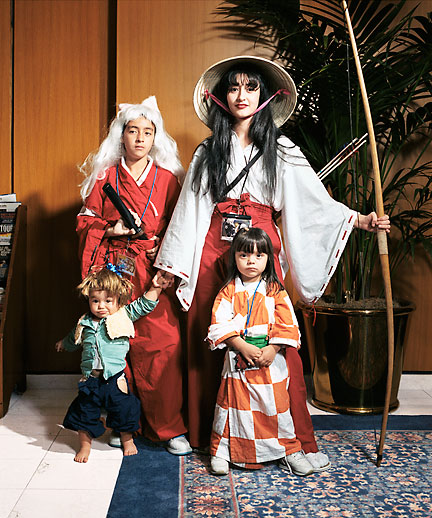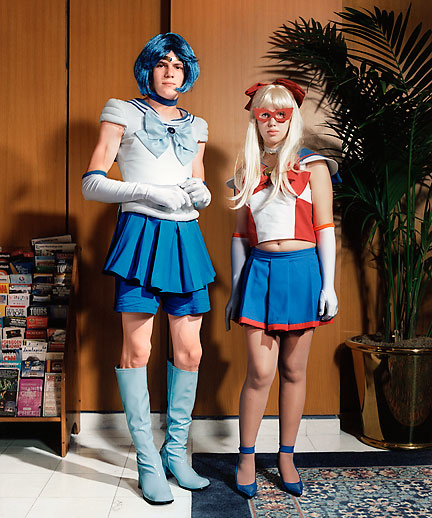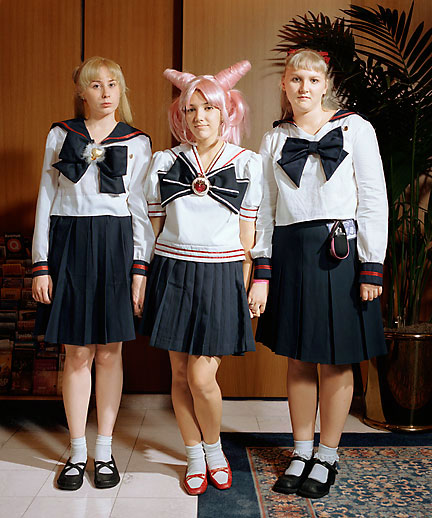Last week, I shared the syllabus for my Transmedia Storytelling and Entertainment class and was blown away by the intensity of interest out there. I don't expect the same level of excitement over this class, since there are many such classes out there around the world, but I figured I would share it just the same. This course is pretty much over-subscribed at USC so I am not trying to attract new students -- just sharing models and resources with others doing work in this area.
What does it mean to be "literate" and how has this changed as a consequence of the introduction of new communication technologies? What social skills and cultural competencies do young people need to acquire if they are going to be able to fully participate in the digital future? What are the ethical choices young people face as participants in online communities and as producers of media? What can Wikipedia and Facebook teach us about the future of democratic citizenship? How effective is Youtube at promoting cultural diversity? What relationship exists between participatory culture and participatory democracy?
How is learning from a video game different than learning from a book? What do we know about the work habits and learning skills of the generation that has grown up playing video games? Who is being left behind in the digital era and what can we do about it? And how might research on pedagogy and learning contribute more generally to our understanding of media audiences? Much of the reading in this course will be drawn from a series of books recently produced by the MIT Press and the MacArthur Foundation. These books reflect a national push by the MacArthur Foundation to explore how young people are learning informally through the affordances of new media and what implications this has for the future of schools, libraries, public institutions, the workplace, and the American family.
This emerging body of research represents an important place where media and communication studies is interfacing with learning researchers and public policy makers. Understanding these debates helps shed light on long-standing debates in media and cultural theory, especially those having to do with the social production of meaning around media content and the nature of online communities. A better understanding of how informing learning, cultural collaboration and knowledge production takes place through fan and game communities may offer key new insights into media audience research and may also help journalists to better understand shifts in how young people access and deploy news and information. At the same time, translating this theory into practice poses challenges which may force our field to rethink some of its core assumptions. This course is intended to be a meeting point between students interested in communications research and cultural studies, media production, and educational research.
The course is structured in two parts: Part One, Learning in a Participatory Culture, seeks to provide an overview of our contemporary moment of media change, of the kinds of informal learning which is occuring in the context of participatory culture, of how schools are responding to the challenges posed by new media technologies, and of core debates between those who value and those who criticize the new media literacies. Part Two, Core Skills and Competencies, digs deeper into what young people need to learn if they are going to become full participants in the emerging media culture, adopting the framework of social skills and cultural competencies which shapes the work of Project New Media Literacies, and illustrating them by looking more closely at such cultural phenomenon as computer game guilds, youtube video production, Wikipedia, fan fiction, Second Life and other virtual worlds, music remixing, social network sites, and cosplay. We will be examining more closely new curricular materials which have emerged from Project New Media Literacies, Global Kids, The Good Play Project, Common Sense Media, the George Lucas Foundation, and other projects which are seeking to introduce these skills into contemporary educational practices.
By the end of the course, students will be able to:
• Map the ways the changing media landscape has impacted the way young people learn
• Identify how participatory cultures work to support the growth and contributions of their members
• Recognize and be able to respond to core debates surrounding the value of bringing new media technologies and participatory culture practices into the classroom.
• Outline some of the ethical challenges which youth face in their roles as media producers and members of online communities.
• Describe our current understanding of the connections between participatory culture and civic engagement, including the relationship between the digital divide and the participation gap.
• Summarize and critique core theorists working in the field of New Media Literacy
• Comprehend the framework of basic social skills and cultural skills associated with the new media literacies
• Apply their theoretical understandings to the development of curricular resources for use in school or after school programs.
• Critique existing curricular resources designed to teach "the new media literacies"
• Deploy course concepts in the development of an independent research project which makes a substantive scholarly contribution.
•
Course Assignments:
• For each class session, the student should make one thoughtful contribution to the class forum, describing their response to the readings, and offering some topics or questions we should explore during the class discussions. This process is designed to jump start the conversation before class so students should make an effort to read their classmate's contributions. Keep in mind that contributions here also allow me to assess your mastery over the course content so try to anchor your comments closely to the readings. You need not, however, reference all of the readings for that week but should focus your discussion on salient points of interest. (10 percent)
• Deploying their emerging understanding of the literature on New Media Literacies and their own personal experience as a user of new media tools and platforms, the student will write a five page response to Mitoko Rich, "Literacy Debate - Online, R U Really Reading?", New York Times Book Review, July 27 2008. The response should consider what counts as literacy, how literacy changes in response to the new media landscape, and what value we should ascribe to the new forms of communication that are emerging online. (Due Week Three) (10 percent)
• The Student will do a short interview with a student or educator, identifying some of their core beliefs about the value of new media technologies and practices for learning, and sketching out how much and in what ways they use such tools and techniques inside and outside of school. Drawing on the literature we've read so far in the class, the student will write a short five page essay which paints a portrait of their interview subject and links them to larger trends impacting how young people are learning through and about new media. (Due Week Six) (20 Percent)
• The Student will develop one challenge for the Project NML Learning Library. Challenges may deploy videos produced by the project or other material that already circulates online. The challenge should reflect their understanding of the "new media" skills and should introduce young people to some aspect of digital culture. (Due Week Ten) (20 Percent)
• The student will complete a paper or project of their own design, with consultation with the instructor, which makes a significant scholarly or pedagogical contribution to our understanding of the new media literacies. A written paper should be roughly 20 pages in length. (due at end of the term) The scale of projects should be negotiated with the professor. The student will make a brief presentation of their paper or project to their classmates during the final class session. (Due Week Fifteen) (40 Percent)
Required Books:
Cory Doctorow, Little Brother (New York: Tor, 2008).
Henry Jenkins, Convergence Culture: Where Old and New Media Collide (New York: New York University Press, 2006).
Peter Lyman, Mizuko Ito, Barrie Thorne, and Michael Carter, Hanging Out, Messing Around, And Geeking Out: Kids Living and Learning With New Media (Cambridge: MIT Press/MacArthur Foundation, 2009).
John Palfrey and Urs Gasser, Born Digital: Understanding the First Generation of Digital Natives (New York: Perseus, 2008).
Colin Lankshear and Michele Knobel, New Literacies: Everyday Practices and Classroom Learning (Maidenshead: Open University Press, 2006).
S. Craig Watkins, The Young and the Digital (Boston: Beacon Press, 2009).
PART ONE: LEARNING IN A PARTICIPATORY CULTURE
Week 1 (August 25) Growing Up Digital
Recommended Readings (For after the first class session):
Mark Prensky, "Digital Natives, Digital Immigrants" (2001)
Henry Jenkins, "Reconsidering Digital Immigrants," Confessions of an Aca-Fan, December 5 2007.
Henry Jenkins, "Eight Traits of the New Media Landscape," Confessions of an Aca-Fan, November 6 2006
Henry Jenkins, "Nine Propositions Towards a Theory of YouTube," Confessions of an Aca-Fan, May 28 2007
Renee Hobbs, "The Seven Great Debates in the Media Literacy Movement"
Week 2 (September 1) The New Media Literacies
Henry Jenkins et al, Confronting the Challenges of a Participatory Culture: Media Education for the 21st Century. , pp.3-23.
James Paul Gee, Good Video Games + Good Learning (New York: Peter Lang, 2007), chapter 8, "Affinity Spaces", pp.87-103.
Colin Lankshear and Michele Knobel, New Literacies: Everyday Practices & Classroom Learning (Maidenhead: Open University Press, 2006). Part One: "What's New?", pp.7-101.
Richard Sennett, The Craftsman (Yale University Press, 2008), Chapter 6 "Expressive Instructions," pp. 179-193.
Week 3 (September 8) The New Digital Landscape: Differing Perspectives
Peter Lyman, Mizuko Ito, Barrie Thorne, and Michael Carter, Hanging Out, Messing Around, And Geeking Out: Kids Living and Learning With New Media (Cambridge: MIT Press/MacArthur Foundation, 2009).
Mark Bauerlein, The Dumbiest Generation: How the Digital Age Stupefies Young Americans and Jeopardizes Our Future. (New York: Tarcher, 2008), Chapter One: "Knowledge Deficits," pp. 11-38 and Chapter Two, "The New Bibliophobes," pp.39-70.
Week 4 (September 15) The Ethics of Participation
Carrie James with Katie Davis, Andrea Flores, James M. Francis, Lindsey Pettingill, Margaret Rundle and Howard Gardner, "Young People, Ethics, and the New Digital Media," pp.1-62.
John Palfrey and Urs Gasser, Born Digital: Understanding the First Generation of Digital Natives (New York: Basic, 2008), "Privacy" pp. 53-82, "Safety" pp. 83-110, "Pirates" pp. 131-154, "Aggressors" pp. 209-222.
Thomas McLaughlin, "The Ethics of Basketball", Give and Go, Basketball as Cultural Practice, State University of New York Press, Albany, 2008. 23-45
Ellen Seiter, "Practicing at Home: Computers, Pianos, and Cultural Capital" in Tara McPherson (ed.), Digital Youth, Innovation and the Unexpected (Cambridge:MIT Press/MacArthur Foundation, 2008), pp. 27-52.
Week 5 (September 22) The Politics of Participation
Cory Doctorow, Little Brother (New York: Tor, 2008).
Justine Cassell and Meg Cramer, "High Tech or High Risk: Moral Panics about Girls Online" in Tara McPherson (ed.), Digital Youth, Innovation and the Unexpected (Cambridge:MIT Press/MacArthur Foundation, 2008), pp. 53-76.
PART TWO: CORE SKILLS AND COMPETENCIES
Week 6 (September 29) Play
Jenkins et al, pp. 22-25.
James Paul Gee, "Learning and Games" in Katie Salens (ed.) The Ecology of Games: Connecting Youth, Games and Learning (Cambridge: MIT Press/MacArthur Foundation, 2008), pp. 21-40.
Kurt Squire and Shree Durga (in press), "Productive Gaming: The Case for Historiographic Game Play," in Robert Fedig (ed.), The Handbook of Educational Gaming (Hershey, PA: Information Science Reference), pp. 1-21.
Mary Louise Pratt, " Arts of the Contact Zone," Profession 91 (1991), pp.33-35.
Eric Klopfer, "Augmented Learning," Confessions of an Aca-Fan, July 7 2008
David Williamson Shaffer, "How Computer Games Help Kids Learn," Confessions of an Aca-Fan, January 25 2007
Week 7 (October 6) Performance
Jenkins et al, pp. 28-31.
James Paul Gee, "Pleasure, Learning, Video Games, and Life: The Projective Stance," in Michele Knobel and Colin Lankshear (eds.), A New Literacies Sampler (New York: Peter Lang, 2007), pp.95-114.
Shelby Ann Wolf and Shirley Brice Heath, "Living in a World of Words," in Henry Jenkins (ed.) The Children's Culture Reader (New York: New York University Press, 1998), pp. 406-430.
Gerard Jones, Killing Monsters: Why Children Need Fantasy, Superheroes, and Make-Believe Violence (New York: Basic, 2002), "The Good Fight," pp. 65-76 and "Fantasy and Reality," pp.113-128.
Geraldine Bloustein, "'Ceci N'est Pas Un Jeaune Femme': Videocams, Representation and 'Othering' In the Worlds of Teenage Girls," in Henry Jenkins, Tara McPherson and Jane Shattuc (eds.) Hop on Pop: The Politics and Pleasures of Popular Culture (Durham: Duke University Press, 2002) pp.162-186.
Week 8 (October 13) Appropriation
Jenkins et al, pp. 32-34.
Henry Jenkins, Convergence Culture: Where Old and New Media Collide (New York: New York University Press, 2006), Chapter 5, "Why Heather Can Write," pp. 169-205.
Rebecca W. Black, "Digital Design: English Language Learners and Reader Reviews in Online Fiction," in Michele Knobel and Colin Lankshear (eds.) A New Literacies Sampler (New York: Peter Lang, 2007), pp.115-136.
Angela Thomas, "Blurring and Breaking Through the Boundaries of Narrative, Literacy, and Identity in Adolescent Fan Fiction," in Michele Knobel and Colin Lankshear (eds.), A New Literacies Sampler (New York: Peter Lang, 2007), pp.137-166.
Lankshear and Knobel, "New Literacies as Remix," pp.105-136.
Week 9 (October 20) Transmedia Navigation and Multitasking
Jenkins et al, pp. 34-36, 46-49.
Gunther Kress, Literacy in the New Media Age (New York: Routledge), Chapter 4 "Literacy and Multimodality: A Theoretical Framework," pp. 35-60.
Henry Jenkins, Convergence Culture: Where Old and New Media Collide (New York: New York University Press, 2006), Chapter 3 "Searching for the Oragami Unicorn," pp. 93-130.
Mimi Ito, "Technologies of the Childhood Imagination: Yugioh, Media Mixes, and Everyday Cultural Production" pp.31-34.
David Buckingham and Julian Sefton-Green, "Structure, Agency and Pedagogy in Children's Media Culture," in Joseph Tobin (ed.), Pikachu's Global Adventure: The Rise and Fall of Pokemon (Durham: Duke University press, 2004), pp.12-33.
Week 10 (October 27) Collective Intelligence and Distributed Cognition
Jenkins et al, pp. 37-43
Henry Jenkins, Convergence Culture: Where Old and New Media Collide (New York: New York University Press, 2006), Chapter One "Spoiling Survivor," pp.25-58.
Jane McGonigal, "Why I Love Bees: A Case Study in Collective Intelligence Gaming" in Katie Salens (ed.), The Ecology of Games: Connecting Youth, Games, and Learning (Cambridge: MIT Press/MacArthur Foundation, 2008), pp. 199-228.
Andrew Clark, Natural-Born Cyborgs: Minds, Technologies and the Future of Human Intelligence (Oxford: Oxford University Press), Chapter Two "Technologies to Bond With," pp. 35-58.
T.L. Taylor, "Does WOW Change Everything?: How a PvP Server, Multinational Playerbase, and Surveillance Mod Scene Caused Me Pause," Games & Culture, October 2006, pp.1-20.
Week 11 (November 3) Simulation and Visualization
Jenkins et al, pp. 25-30.
Ian Bogost, "Procedural Literacy: Problem Solving in Programming, Systems and Play," Telemedium: The Journal of Media Literacy, 52, 2005, pp.32-36.
Rachel Prentice, "The Visible Human," in Sherry Turkle (ed.), The Inner History of Devices (Cambridge: MIT Press 2008), pp. 112-124.
Sherry Turkle, Life on Screen: Identity in the Age of the Internet (New York: Touchstone, 1996), Chapter Nine "Virtuality and Its Discontents," p.233-254
Barry Joseph, "Why Johnny Can't Fly: Treating Games as a Form of Youth Media Within a Youth Development Framework," in Katie Salen (Ed.), The Ecology of Games: Connecting Youth, Games, and Learning (Cambridge: MIT Press/MacArthur Foundation, 2008), pp. 253-266.
Week 12 (November 10) Networking
Jenkins et al, pp. 49- 52.
danah boyd, "Why Youth Social Network Sites: The Role of Networked Publics in Teenage Social Life," in David Buckingham (ed.) Youth, Identity and Digital Media (Cambridge: MIT Press/MacArthur Foundation, 2009), pp. 1-26
W. Lance Bennett, "Changing Citizenship in the Digital Age" in W. Lance Bennett (ed.), Civic Life Online: Learning How Digital Media Can Engage Youth (Cambridge: MIT Press/MacArthur Foundation, 2009), pp. 1-24.
Yasmin B. Kafai, "Gender Play in a Tween Gaming Club," in Yasmin B. Kafai, Carrie Heeter, Jill Denner, and Jennifer Y. Sun (eds.), Beyond Barbie & Mortal Kombat: New Perspectives on Gender and Gaming (Cambridge: MIT Press, 2008), pp.110-123.
Elizabeth Hayes, "Girls, Gaming, and Trajectories of IT Expertise," in Yasmin B. Kafai, Carrie Heeter, Jill Denner, and Jennifer Y. Sun (eds.) Beyond Barbie & Mortal Kombat: New Perspectives on Gender and Gaming (Cambridge: MIT Press, 2008), pp.217-230.
Vanessa Bertozzi, Unschooling and Participatory Media (Master's Thesis, Comparative Media Studies, MIT, 2006), "Carsie's Network: Connecting a Geographically Dispersed Population," pp. 98-123.
Week 13 (November 17) Negotiation
Jenkins et al, pp.52-55.
S. Craig Watkins, The Young and the Digital (Boston: Beacon Press, 2009)
Antonio Lopez, "Circling the Cross: Bridging Native America, Education, and Digital Media" in Anna Everett (ed.), Learning Race and Ethnicity: Youth and Digital Media (Cambridge: MIT Press/MacArthur Foundation, 2008). pp. 109-126.
Week 14 (November 24) Judgement
Jenkins et al, pp. 43-46
Henry Jenkins, "What Wikipedia Can Teach Us About the New Media Literacies," Journal of Media Literacy,
Axel Bruns, "Educating Produsers, Produsing Education," Blogs, Wikipedia, Second Life, and Beyond: From Production to Produsage (New York: Peter Lang, 2008), pp.337-356.
Andrew J. Flanagin and Miriam J. Metzger, "Digital Media and Youth: Unparalleled Opportunity and Unprecedented Responsibility,"In Andrew J. Flanagin and Miriam J. Metzger (eds.), Digital Media, Youth, and Credability (Cambridge: MIT Press/MacArthur Foundation, 2008), pp. 5-28.
Week 15 (December 1) Student Presentations






